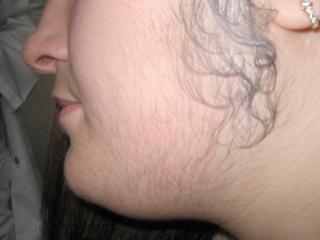
Hirsutism is excessive body hair on parts of the body where hair is normally absent or minimal. The word is from early 17th century: from Latin hirsutus meaning "hairy". It usually refers to a male pattern of hair growth in a female that may be a sign of a more serious medical condition, especially if it develops well after puberty. Cultural stigma against hirsutism can cause much psychological distress and social difficulty. Discrimination based on facial hirsutism often leads to the avoidance of social situations and to symptoms of anxiety and depression.
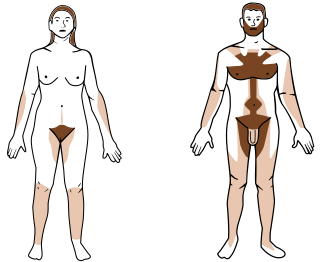
Hair removal, also known as epilation or depilation, is the deliberate removal of body hair or head hair.

A beard is the hair that grows on the jaw, chin, upper lip, lower lip, cheeks, and neck of humans and some non-human animals. In humans, usually pubescent or adult males are able to start growing beards, on average at the age of 21.

A moustache is a growth of facial hair grown above the upper lip and under the nose. Moustaches have been worn in various styles throughout history.

Wilgefortis is a female folk saint whose legend arose in the 14th century, and whose distinguishing feature is a large beard. According to the legend of her life, set in Portugal and Galicia, she was a teenage noblewoman who had been promised in marriage by her father to a Moorish king. To thwart the unwanted wedding, she had taken a vow of virginity, and prayed that she would be made repulsive. In answer to her prayers she sprouted a beard, which ended the engagement. In anger, Wilgefortis' father had her crucified.
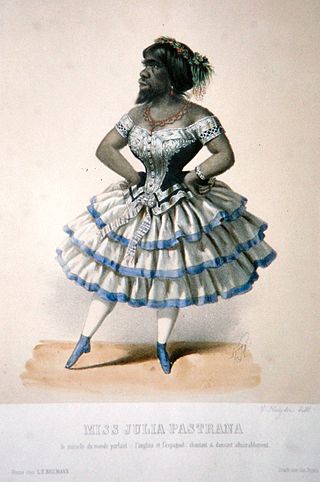
Julia Pastrana was a performer and singer during the 19th century who had hypertrichosis. Pastrana, an indigenous woman from Mexico, was born in 1834, somewhere in the state of Sinaloa. She was born with a genetic condition, hypertrichosis terminalis ; her face and body were covered with straight black hair. Her ears and nose were unusually large, and her teeth were irregular. The latter condition was caused by a rare disease, undiagnosed in her lifetime, gingival hyperplasia, which thickened her lips and gums.
Underarm hair, also known as axillary hair or armpit hair, is the hair in the underarm area (axilla).

Josephine Clofullia (1829–1870) was a famous Swiss-born bearded lady who is most famous for being part of P. T. Barnum's "American Museum."
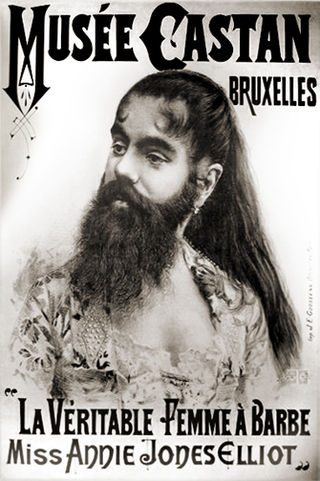
Annie Jones Elliot was an American bearded woman, born in Virginia. She toured with showman P. T. Barnum as a circus attraction. Whether the cause of her condition was hirsutism or an unrelated genetic condition that affects children of both sexes and continues into adult years is unknown. Many photographers, including Mathew Brady, took her portraits during her lifetime, which were widely distributed. As an adult, Jones became the country's top "bearded lady" and acted as a spokesperson for Barnum's "Freaks", a word she tried to abolish from the business. Jones married Richard Elliot in 1881, but divorced him in 1895 for her childhood sweetheart William Donovan, who died, leaving Jones a widow. In 1902, Jones died in Brooklyn of tuberculosis.
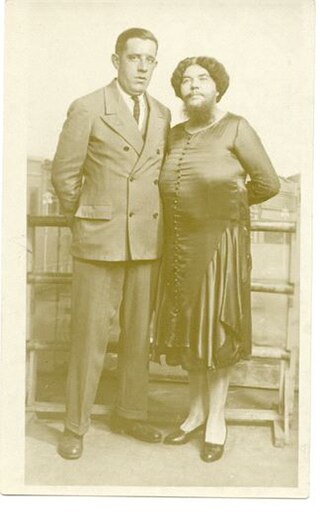
Jane Barnell was an American bearded lady who worked in circus sideshows, dime museums and carnivals, who used various stage names including Princess Olga, Madame Olga and Lady Olga. In her only film role in Tod Browning's cult classic Freaks, using the sideshow stage name Olga Roderick, she was billed as the "Bearded Lady".

Hyperandrogenism is a medical condition characterized by high levels of androgens. It is more common in women than men. Symptoms of hyperandrogenism may include acne, seborrhea, hair loss on the scalp, increased body or facial hair, and infrequent or absent menstruation. Complications may include high blood cholesterol and diabetes. It occurs in approximately 5% of women of reproductive age.

Hypertrichosis is an abnormal amount of hair growth over the body. The two distinct types of hypertrichosis are generalized hypertrichosis, which occurs over the entire body, and localized hypertrichosis, which is restricted to a certain area. Hypertrichosis can be either congenital or acquired later in life. The excess growth of hair occurs in areas of the skin with the exception of androgen-dependent hair of the pubic area, face, and axillary regions.
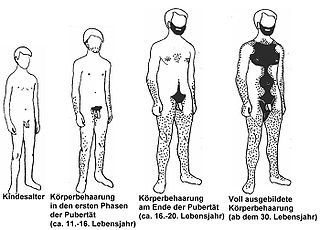
Body hair or androgenic hair is terminal hair that develops on the human body during and after puberty. It is different from head hair and also from less visible vellus hair, which is much finer and lighter in colour. Growth of androgenic hair is related to the level of androgens and the density of androgen receptors in the dermal papillae. Both must reach a threshold for the proliferation of hair follicle cells.
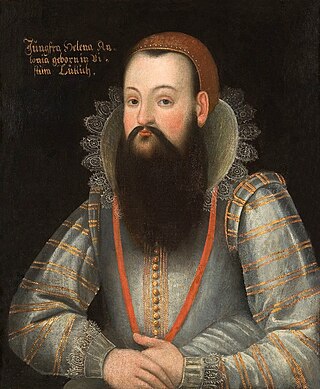
Helena Antonia was a bearded female court dwarf of Maria of Austria, Holy Roman Empress and was a favorite of Margaret of Austria, Queen of Spain, and also a lady-in-waiting for Constance of Austria, Queen of Poland.

Facial hair is hair grown on the face, usually on the chin, cheeks, and upper lip region. It is typically a secondary sex characteristic of human males. Men typically start developing facial hair in the later stages of puberty or adolescence, around fifteen years of age, and most do not finish developing a full adult beard until around eighteen or later. However, large variations can occur; boys as young as eleven have also been known to develop facial hair, and some men do not produce much facial hair at all.
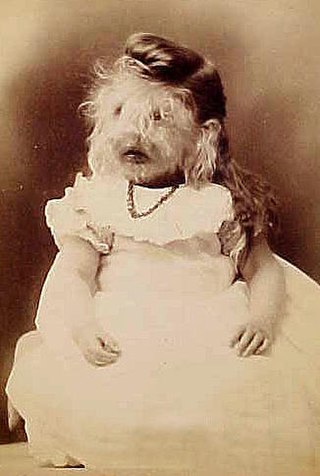
Prepubertal hypertrichosis, also known as childhood hypertrichosis, is a cutaneous condition characterized by increased hair growth, found in otherwise healthy infants and children. Prepubertal hypertrichosis is a cosmetic condition and does not affect any other health aspect. Individuals with this condition may suffer with low self esteem and mental health issues due to societal perceptions of what a "normal" appearance should be. The mechanism of prepubertal hypertrichosis is unclear, but causes may include genetics, systemic illnesses, or medications.
Pogonophobia is the fear of beards.
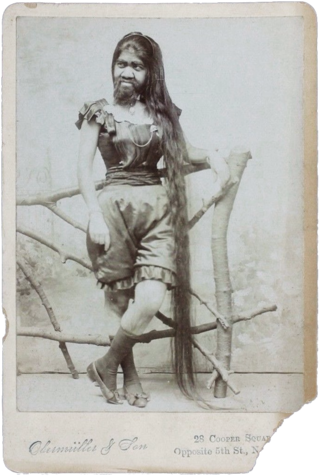
Krao Farini was an American sideshow performer who was born with hypertrichosis and took part in 19th-century exhibition tours in North America and Europe. She was adopted by William Leonard Hunt, also known as Guillermo Antonio Farini, who exploited her appearance. Throughout her life she was falsely advertised as a primitive human and billed as the missing link between humans and apes.

Alice Elizabeth Doherty was an American woman born with the condition hypertrichosis lanuginosa.

Harnaam Kaur is a British social media personality, postpartum coach, life coach and motivational speaker.


















